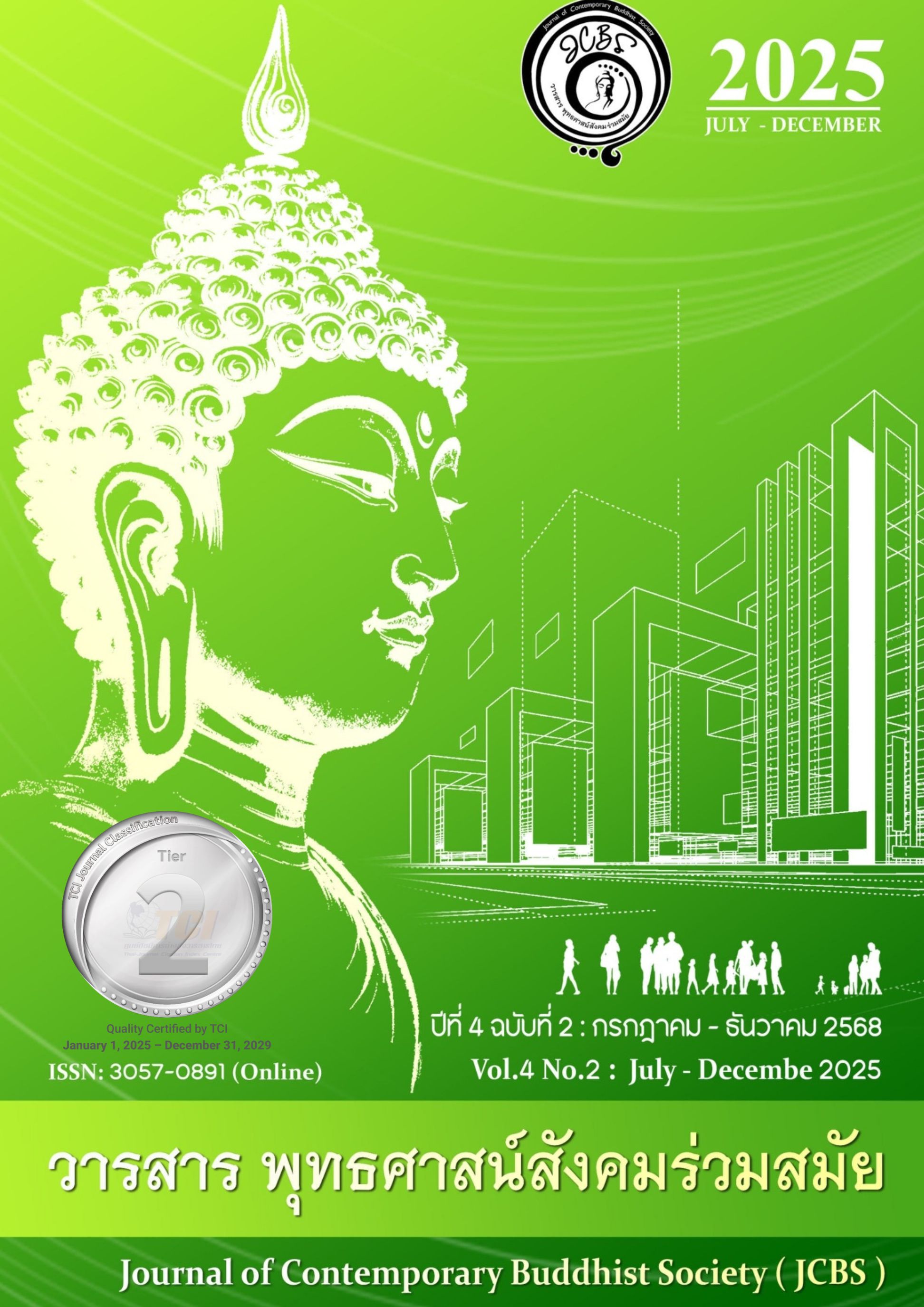ADMINISTRATIVE MODELS FOR ENHANCING RELATIONSHIPS BETWEEN PRIMARY SCHOOLS AND COMMUNITIES: A CASE STUDY OF THE CHANTHABURI PRIMARY EDUCATIONAL SERVICE AREA OFFICE
Keywords:
School Administration; Community Relations; Primary Educational Service Area OfficeAbstract
This academic article aims to examine the models and approaches of school administration for enhancing community relations in primary schools under the supervision of the Chanthaburi Primary Educational Service Area Office. The study considers the roles of school administrators, administrative processes, participation of school personnel, and the effectiveness of school–community relationship development. The content focuses on analyzing administrative processes that emphasize community participation across planning, implementation, evaluation, and continuous development stages. The article highlights the importance of two-way communication between schools and communities, as well as the engagement of community leaders, parents, local organizations, and other stakeholders in co-thinking, co-creating, and co-developing educational initiatives.
Findings reveal that effective administrative models consist of three core components 1) continuous two-way communication between the school and the community, 2) participatory planning at all levels, which fosters a sense of ownership and ensures the sustainability of projects, and 3) partnership linkage through collaborative network structures. Three prominent administrative models were identified: 1) Policy Co-creation Model – involving joint policy formulation with local administrative organizations, 2) vertical Network Model – focusing on strategic coordination with central or affiliated agencies, and 3) local Stakeholder Participation Model – opening space for local partners to actively engage in educational development. These models are aligned with the cultural context and social structures of Chanthaburi province. Thus, administration aimed at fostering school–community relationships must go beyond basic coordination. It requires goal-oriented planning, a clear vision, and sustained participatory mechanisms to truly position the school as a center for learning and community quality-of-life development.
References
คุณวุฒิ คนฉลาด. (2540). ภาวะผู้นำ (พิมพ์ครั้งที่ 2). ชลบุรี: คณะศึกษาศาสตร์ มหาวิทยาลัยบูรพา.
จารุวรรณ ตาลสุกเรือง. (2565). รูปแบบการบริหารตามศาสตร์พระราชาเพื่อพัฒนาคุณภาพผู้เรียนใน
สถานศึกษา สังกัดสำนักงานเขตพื้นที่การศึกษาประถมศึกษา. วิทยานิพนธ์ปริญญาดุษฎีบัณฑิต สาขาวิชาการบริหารการศึกษา : มหาวิทยาลัยนเรศวร.
จิรศักดิ์ จันกัน. (2566). รูปแบบการพัฒนาสมรรถนะความเป็นผู้ประกอบการของนักศึกษาในสถานศึกษา
สังกัดสำนักงานคณะกรรมการการอาชีวศึกษา. วิทยานิพนธ์ปริญญาดุษฎีบัณฑิต สาขาวิชาการบริหารการศึกษา : มหาวิทยาลัยนเรศวร.
ฐิตาพร พุ่มแดง. (2567). รูปแบบการบริหารจัดการการถดถอยทางการเรียนรู้ของนักเรียนในสถานศึกษา.
Journal of Arts Management, 8(1), 498-517.
ธงชัย สันติวงษ์. (2543). องค์การและการบริหาร (พิมพ์ครั้งที่ 11). กรุงเทพมหานคร: ไทยวัฒนาพานิชย์.
ธีระ รุญเจริญ, ปราชญา กล้าผจัญ และสัมมา รธนิจย์. (2554). การบริหารเพื่อปฏิรูปการเรียนรู้. กรุงเทพฯ :
ข้าวฟ่าง.
นพธี หอมชื่นชม. (2564). การบริหารความสัมพันธ์ระหว่างโรงเรียนกับชุมชนที่ส่งผลต่อผลสัมฤทธิ์ทางการ
เรียนและการจัดการเรียนรู้ของครูในสถานศึกษาระดับมัธยมศึกษาในจังหวัดนครปฐม. วารสารบริหารการศึกษา มศว, 19(36).
นฤมล พุฒิฤทธิ์. (2566). รูปแบบการบริหารสถานศึกษาโดยใช้โรงเรียนเป็นฐาน สังกัดสำนักงานเขตพื้นที่
การศึกษาประถมศึกษาจันทบุรี เขต 2. วารสารวิจัยมหาวิทยาลัยเวสเทิร์น มนุษยศาสตร์และสังคมศาสตร์, 9(2).
นาวิน แกละสมุทร. (2562). การส่งเสริมความสัมพันธ์ระหว่างโรงเรียนกับชุมชนของโรงเรียนวัดใหญ่บ้านบ่อ
สำนักงานเขตพื้นที่การศึกษาประถมศึกษาสมุทรสาคร. วิทยานิพนธ์ศึกษาศาสตรมหาบัณฑิต สาขาวิชาการบริหารการศึกษา : มหาวิทยาลัยศิลปากร.
รัตนา กาญจนพันธุ์. (2556). ความสัมพันธ์ระหว่างโรงเรียนกับชุมชน. กรุงเทพฯ : มหาวิทยาลัยรามคำแหง.
วาสนา ชูแสง. (2557). การดำเนินงานการสร้างความสัมพันธ์ระหว่างโรงเรียนกับชุมชนของโรงเรียนสังกัด
สำนักงานเขตราษฎร์บูรณะ กรุงเทพมหานคร. วิทยานิพนธ์ครุศาสตรมหาบัณฑิต สาขาวิชาการบริหารการศึกษา : มหาวิทยาลัยราชภัฏธนบุรี.
สมเดช สีแสง. (2547). คู่มือการบริหารโรงเรียนสถานศึกษาขั้นพื้นฐานตาม พ.ร.บ. การศึกษาแห่งชาติ.
ชัยนาท : ชมรมพัฒนาความรู้ด้านระเบียบกฎหมายและพัฒนามาตรฐานวิชาชีพครู.
สมยศ นาวีการ. (2545). การบริหารเพื่อความเป็นสุข. กรุงเทพฯ: บรรณกิจ.
Daft, R. L. (2000). Management (5 th ed.). New York: Harcourt College.
Fayol, H. (1916). General and industrial management. Institute of Electrical and Electronics
Engineering.
Gulick, L. and Urwick, L. (1937). Papers on the Science of Administration. Institute of Public
Administration, New York.
Heinz Weihrich, Harold Koontz. (1993). Management, A Global Perspective. 10th (ed.),
McGraw Hill.
Stoops, E., & Rafferty, M. L. (1961). Practice and trends in school administration. New York:
Ginn.
Sumtion, M. L. (1996). School community relation. New York: McGraw-Hill.
Downloads
Published
How to Cite
Issue
Section
License
Copyright (c) 2025 Journal of Contemporary Buddhist Society = JCBS

This work is licensed under a Creative Commons Attribution-NonCommercial-NoDerivatives 4.0 International License.



